VIDEO FEATURE & WEB-EXCLUSIVE INTERVIEW
Musician: PETER WHITE
Music Video: “Groovin’”
Songwriters: Felix Cavaliere & Eddie Brigati
PETER WHITE Web-Exclusive Interview
with M Music & Musicians magazine publisher, Merlin David
For his fifteenth recording as a leader, Peter White, the former Al Stewart sideman (who co-wrote the 1978 hit “Time Passages”) returns to some of his favorite tracks from the 60s and 70s, including Stevie Wonder’s “Do I Do,” Otis Redding’s “(Sittin’ On) The Dock of the Bay,” and John Lennon and Paul McCartney’s “Here, There and Everywhere.”
Peter White started playing the electric guitar when he was a young boy, inspired in part by the music of groups like the Rolling Stones and the Beatles. When an accidental fire destroyed his electric guitar, White transitioned to the acoustic guitar and a jazz icon was born. After receiving his first professional booking when he was only 19 years old, Peter White joined Al Stewart’s band as a keyboardist on the famous singer-songwriter’s international tour through England, Scotland and the United States. White and Stewart continued to work together over the years, collaborating on the release of the major 1976 hit, “Year of the Cat.”
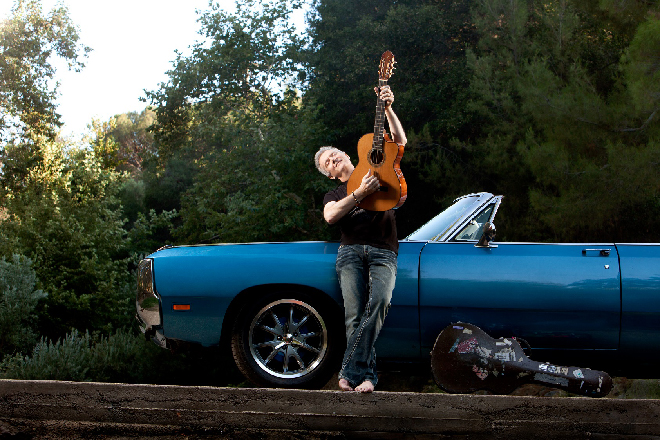
Photo Credit – Lori Stoll
Like so many millions of us, guitarist Peter White still feels closest to the music he absorbed while growing up. As a British teen in the 60s, he kept his ears glued to the radio—soaking up the exciting new sounds of rock bands like the Beatles and soul giants like Stevie Wonder—and tried to learn how to play those songs on the acoustic guitar his dad had given him. It didn’t take him long to get the hang of it, and now, after more than four decades as both a leader and sideman, he’s returning to those tunes that impacted him so forcefully in his youth.
Groovin’, released on October 28, 2016, is White’s third collection of guitar-centric interpretations of timeless compositions from those halcyon years of the 1950s to the 80s. Taking up where his previous all-covers albums Reflections (1994) and Playin’ Favorites (2006) left off, Groovin’ finds White not only nostalgic but adventurous and playful, injecting vocal shadings and bold horn charts into the mix, and even some tougher guitar sounds than he’s generally known for.
Groovin’ takes its title from the Rascals’ tropical-hued ballad hit of 1967, and also includes, from that heady decade, the Beatles’ “Here, There and Everywhere.” From the same era, the R&B classic “I Heard It Through the Grapevine,” a hit for both Marvin Gaye and Gladys Knight, gets a distinctive new reading here by White, as does Otis Redding’s timeless “(Sittin’ On) The Dock of the Bay.” The oldest tune, “Sleep Walk,” was a number one instrumental hit in 1959 by Santo and Johnny in the United States, but White actually heard it first by the Shadows, a British guitar combo massively popular in the U.K. that never really caught on in the States. For White, the challenge in interpreting such familiar music is in putting his own stamp on a number while retaining the characteristics that make it instantly recognizable.
Peter White talked with us about his creative process—for writing songs and interpreting songs we have heard before—along with playing the guitar and piano, and most of all what he wants to do with his music—to move people.
How did the idea of interpreting The Young Rascals’ “Groovin’” come to you?
Toots Thielemans, the great Belgian harmonica player who just passed away recently, said “People ask me if any of the new music impresses me.” And he said, “I’m too old to be impressed—I want to be moved.” When I record these old songs that everybody knows, I try to record them in the way that if I had heard this song for the first time—if somebody just played this song for me or sang it to me, how would I record it today—without knowing anything about these previous recordings. I don’t do any research on these songs. I rely completely on my memory of the song. That way, I don’t get too close to the original arrangement—because that’s not my intention.
In the original version, it was Chuck Rainey’s amazing bass lines that moved people. How did you choose trumpeter Rick Braun for your version?
I knew something was missing in the song, and I even tried a harmonica solo. I’m an amateur harmonica player, but it just didn’t sound right. I tried some sax. But then I thought, if you’re ever in trouble with a song—who do you call? Rick Braun. He could do no wrong as far as I am concerned. Whatever he plays just has the magic touch. He’s also a good friend of mine for over 20 years—and we play together all the time.

Photo Credit – Lori Stoll
Tell us how the new album Groovin’ evolved—and how the concept differs from the 2006 Playin’ Favorites or the 1994 Reflections album?
It’s just really a continuation, but with more horns on this album. There’s a horn section that I recorded in New York with friends of mine—the Harris Brothers—Don and Dave Harris. Don came up with these great arrangements. I also had more background vocals on this album than ever before. It’s almost like greatest hits of classic songs. Every 10 years or so, I get this feeling that I want to record these songs. It’s really fun for me. I did three albums back-to-back of all original songs which I promised myself and the fans I would do. I have a lot of ideas left over from the Playin’ Favorites album. These songs really struck me as a teenager in the 70s. The songs I’ve chosen to re-do are all from the 70s and 60s (one from 80s)—all before the digital revolution. I think that when music started to get digitized, we got far greater production values. So you could take a song that’s not so great—and make it sound great. But older songs, you had to have an amazing song. It had to stand by itself—without the production. That’s when music meant so much to me—probably more than it does now. I think it was just because I was a teenager then. Or maybe music was just better then—that’s what I tend to think. (Laughs) Al Stewart wrote some wonderful songs, and that’s how I ended up playing for Al for 20 years.
When you left Al Stewart, did you find your own replacement?
Do you know how I met Dave Nachmanoff—who now plays for Al Stewart? I was doing a show with Al in San Francisco at the Great American Music Hall. And Dave came up to me after the show and said, “Hi, you know I love Al’s music, and I love your guitar playing. I’ve studied your guitar playing and I can play kind of like you.’ I said, ‘Really?’ and I gave him my guitar, and he started to play—just like me. And I said, ‘Well Dave, one day you can replace me!’ (Laughs) So when I got too busy doing my own solo gigs, and I couldn’t play with Al anymore—after 20 years—I said to Al, ‘Why don’t you call Dave Nachmanoff?’ Yes, that’s exactly how it happened. ‘He knows all the songs, he can play all the parts—just give him a call. He’ll be able to slot right in.’ And that’s what happened.
For your own songs, what is your creative process for songwriting?
I don’t write songs like I used to. There are a lot of distractions—especially with social media. Now you have to talk about music—whereas in the past, we just used to play music. (Laughs) I just find that if you enter your head, then ideas just come. And the best time is in the morning. And sometimes, if you think too much—the ideas will not come because music is about feeling. Whenever I start thinking too much, I just get up and maybe go to the fridge, and this always works. I open the refrigerator and all of a sudden, the ideas start coming because you’re not thinking anymore. Your mind exists and you start feeling. Your mind can’t be in two places—it can either think or feel, but it can’t do both. You’ll have to get out of your way. You’ll hear musicians and athletes talking about it. You get out of your own way and let your body and mind do what it does. In basketball, they talk about being in the zone.
Tell us one experience where something unique inspired you to write a song.
Sometimes I’ll hear random sounds—or random pieces of music—a few notes from a song on the radio, and all of a sudden something comes to me. But generally when I come up with ideas I’m usually in isolation—sitting in a dark room somewhere without distractions—when songs come to me. You have to remove distractions in order for your ideas and feelings to come through. Most writers talk about being in an empty room, and put a page in front of you. And there are others who say ‘I want to be inspired’—and they go to these beautiful places. But for me, if I go to a beautiful place, I’m thinking of the beautiful place—and not about music.
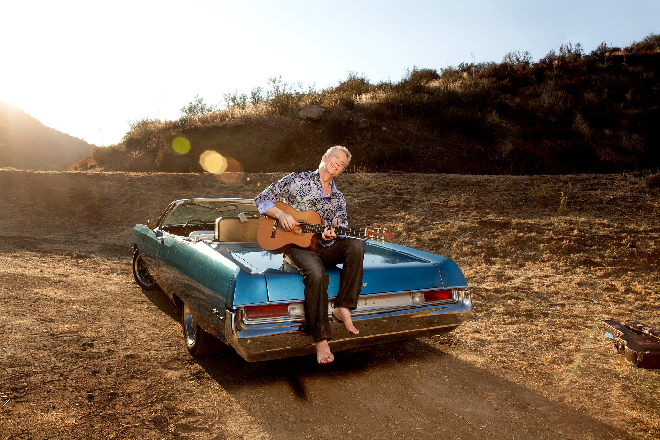
How does where you live or travel influence your music?
I think the music I listened to while I was growing up in England—had a big influence on me. It was the same music everyone was listening to back then. I listened to the radio. And we probably heard more English music, but along with the Beatles and the Rolling Stones I was listening to Motown, the Temptations and the Supremes—just like everybody. Along with rock ’n’ roll, I was listening to Motown. I remember the first time I heard Marvin Gaye—“Heard It Through the Grapevine” when I was 12 or 13. Heavily involved in rock ’n’ roll, and all of a sudden—here comes Marvin Gaye. And I don’t even know what the grapevine is! But I just thought it was a lovely, haunting song.
Guitar is your main instrument, but I believe you play accordion and piano. Who influenced you to pick up the instruments you now play, and how old were you?
I play all of those instruments, but guitar is my main instrument. When I’m recording, that’s what I play for melody, but I also played all the keyboards on the album. I just don’t play keyboards on stage because I already have a great keyboard player. I started with Al Stewart when I was 20 years old, and he hired me to play keyboards. He didn’t even know that I could play the guitar—and he didn’t care. He didn’t want a guitar player, he already had one. In England, if you wanted to play guitar, you were competing with everyone and their brother. But if you played keyboards, you had a chance. Most people who played piano would either go into classical music or go into jazz, but I was into rock ’n’ roll. I liked Emerson, Lake & Palmer. I always wanted to meet Keith Emerson, and I never did. I credit Keith Emerson for my music career. And if I would have met him, I would have told him that. If it wasn’t for Keith Emerson, I wouldn’t have continued my piano studies. I was so into the guitar that I had pretty much given up on the piano. But that first ELP album was a huge influence.
What about the guitar attracted you?
Guitar riffs of the Beatles (imitates a Beatles’ song). The twang on the bottom strings was so appealing. But it was a slow process to learn all the riffs.
What songwriting tip would you like to offer?
We get into this trap of ‘what should I be doing?’ ‘How can I write a hit song?’ All of that deals with the rational part of your mind, but music comes from feeling. So you have to stop thinking. Go on a walk through the countryside—look at nature, and realize what a wonderful thing it is to be alive. Once you do something where you aren’t thinking—that’s when you will start to write.
Who inspired you to write songs?
That’s a very good question! I didn’t really write songs as a teenager—I just dabbled. I struggled with how to create something out of nothing. Then one day I was watching a Fred Astaire movie, and I started to realize “Hey, there are some great songs in this movie.” It was the first time I realized great songs were written before the Beatles. “Cheek to Cheek” (sings): Heaven, I’m in Heaven. The whole basis of music is a great song—that’s what endures. And when I heard Irving Berlin’s songs, the songs were already 30 years old—it had lasted all those years. You have to understand that the Beatles were like a tidal wave that swept all of us away. But going back to the old black and white movies, it was so wonderful to discover great songs. Those movies and the songs made a huge impact on me.
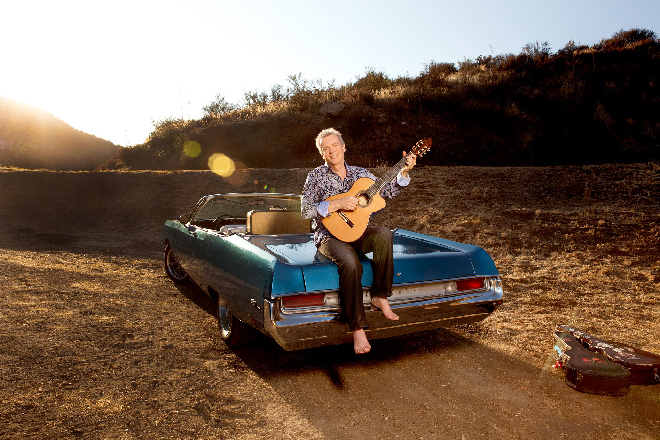
What was the inspiration for the 1978 hit “Time Passages” with Al Stewart?
I was at my mother’s house in Letchworth Garden City—flicking through radio channels. All of a sudden, I heard something in the back of my head—and that’s when the intro came to me. I played it over and over again. Al heard it and said, “I like that. We could write a song around that.” I couldn’t believe I was getting the opportunity to write my first song with someone who had such a huge album with Year of the Cat. I was very enthusiastic to write with Al.
Where were you when you first heard one of your songs on the radio?
Funny, I never thought about this before. I love these questions. I was on Sunset Blvd at the corner of Holloway Drive, at a restaurant, when I first heard my song on the sound system. I never imagined I’d be on the radio. So when it happened, I was flabbergasted. I played lead on “On the Border.” Al wanted a Spanish guitar part on that song, and I didn’t even have one. So Al gave me his Spanish guitar, I played the lead—and gave the guitar back to him. It started me on the road to where I am today—as a guitarist. People seemed to really like that sound. I wasn’t even playing guitar for Al at the time. I was playing keyboards. Al already had an amazing guitarist, Tim Renwick, who played all the guitars. But this opportunity to play the Spanish guitar came up, and it changed my life.
Tell us about a musical hero you played with.
I played with Grover Washington Jr. We recorded one of my songs, “Midnight in Manhattan”—and that was amazing. David Sanborn and I also played together, and that was on my bucket list.
It was funny because Gregg Karukas and I were talking about it, and I said I’d like to have Sanborn play, and he said, “Oh, he’s not going to do that.” And I said, “Well, he said he would.” (Laughs) It was like a dream come true to have Sanborn play on my album.
Top 5 Musicians or Songwriters who inspired you to become a musician?
Keith Emerson, Hank Marvin, the Beatles, Eric Clapton, Led Zeppelin, Joe Pass, George Benson, Steve Howe. Sorry, that’s eight. Keith of course was a huge inspiration. And most people won’t know Hank—the lead guitarist for the Shadows—huge in England. The Beatles of course were a huge influence. Clapton with Cream is when I grew my hair long and couldn’t believe we could reduce music to just three people—bass, drums and guitar. Then I discovered Zeppelin. I was never really into jazz, but a friend of mine at school was really into it, and I heard Joe Pass play Portraits of Duke Ellington, and I couldn’t believe how well just one guitar could produce so many different sounds. Then, Benson’s Breezin’ changed everything even more, and I was so glad that I later had the opportunity to tell him how much he inspired me. Oh, and Steve Howe—I heard him play a major scale on the guitar—and that changed my life. If you were a guitarist when I was growing up, all you did was play the blues. But Howe changed all of that for me.
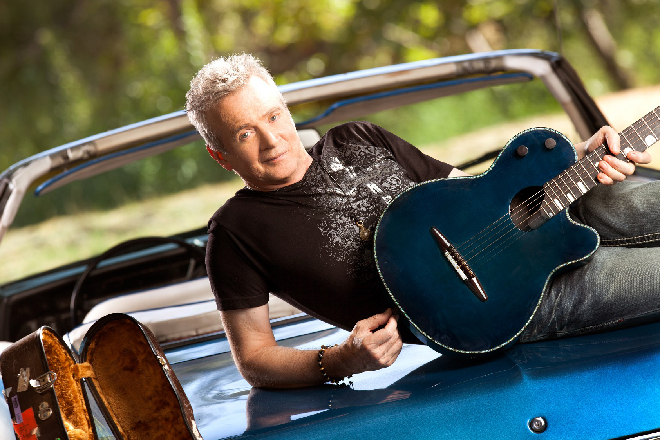
Photo Credit – Lori Stoll
What instrument/equipment can you not live without—that helps you write, record or perform?
The guitar on this album is interestingly a Guild nylon string guitar. I bought it at a used guitar store, as I do most of my guitars. I have an Asturias guitar, it’s a Japanese-made guitar. I bought it because it had a cutaway, and it’s on the front of my Glow album. But the guitar I play live is a Paul McGill guitar. He’s a friend of mine, and his nylon string guitar is amazing to play live because it resists feedback. I mostly play the blue guitar, but I play the white guitar for my Christmas concert season.
Any other instruments?
Al asked me if I could play accordion, and I said “yes.” But I didn’t know how to. (Laughs) So I just learned it. Now, I’ve actually been hired by people to play accordion. For Basia, I played accordion on “Rachel’s Wedding.” But I have a long working relationship with Basia. I played all the guitars on Time and Tide. I played on most of her albums. Thank you, Danny White (my brother)! His getting me to play on Basia’s albums almost made up for setting fire to my electric guitar by “accident.” Danny had a band called Matt Bianco (bianco—white) and Basia was the vocalist.
Which PRO are you with?
First time I became aware is when I wrote “Time Passages.” I didn’t have any agreement. Al’s manager said BMI will give you an advance (larger check of $25K)—more than I’d ever seen in my life. It was on the radio, and I was able to pay my rent. I later signed with ASCAP.
What are your Top 5 favorite albums of all time?
Live & Well (1996) – The Gap Band—in Atlanta. Never realized Charlie was such a genius.
Introspective (1988) – Pet Shop Boys—genius from the beginning notes to the last. I never liked any other album quite so much. Interestingly, very little guitar on that album!
Breezin’ (1976) – George Benson
Heart String (1979) – Earl Klugh
Secret Story (1992) – Pat Metheny—the orchestration is like a movie. By the time I get to the end, I am drained. I also had the wonderful opportunity to tell him how much he influenced me. But the craziest thing happened. When we met, the first thing Pat said to me, “Didn’t you meet my parents in Kansas City?” I did a show with Kirk Whalum, Marc Antoine and Everette Harp, and Lois Metheny (Pat’s Mom) came up to me after the show, as a fan, and she later told Pat about meeting me. I was so honored that Pat remembered.
Symphony No. 40 & No. 41 – Mozart—last two symphonies.
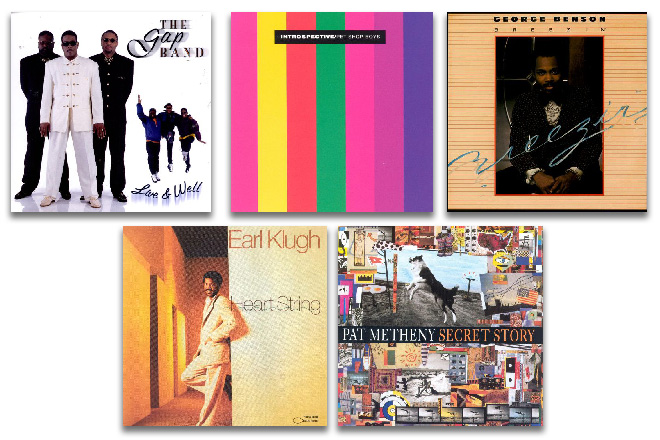
On your first solo album Réveillez-Vous, the song “Play Your Guitar for Me” is co-written by Skipper Wise. Is that the same Skipper from Blue Microphones?
Wow! You’re the first person to ever ask me that question. Yes, it is. In those days, we were neighbors. It was fortuitous that I met Skipper. We lived behind Ventura Blvd (at Van Nuys)—he was building a studio, and we helped each other on recordings. I even lent him money sometimes to buy mics advertised in the Recycler. (Laughs) Skipper actually co-produced my first two albums. I’ve known him for years, and we are still friends.
Best advice someone has given you.
When I was recording Al Stewart’s Year of the Cat album at Abbey Road Studios, Alan Parsons was the producer. We were recording “On the Border,” and I played from beginning to end. I felt real good about my guitar parts. The tape stopped at the end, and there was silence. The control booth is on the next floor up, and I was just waiting. And after what seemed like a very long silence, I heard, “OK, let’s try that again.” And then after a pause, Alan said, “But this time, wait until Al stops singing, and then start playing.” It actually was the best advice I was given. Guitarists think ‘everyone needs to hear my riffs.’ But it was a great lesson: you don’t have to play all the way from the front of the song—let the song speak. Now, I resist playing in the intro. Then when the melody comes in, it makes a stronger statement. I usually just play harmonics in the intro.
Best advice you’d like to give.
Let the song develop, and then play. Really, an expansion of the best advice I was given. It’s interesting that people know me as a guitar player, but I actually play piano. Most of the songs, I write on the piano. Or when I arrange music or show someone how it goes, I play it on the piano. On the piano, you have 10 fingers—and you can create bass, melody and harmony. So, my advice would be—learn to play the piano, and maybe also learn to sing. John Mahon played in my band, but about 20 years ago got a call to play with Elton John—to sing high harmonies. Singing will help with your longevity as a musician—helps you diversify. Also learn studio production. Learn to play other people’s songs, and make it sound good. I had an 8-track studio, and recorded other people—and made my living that way. Diversify—learn a lot of things.
What’s next?
In October, I got back from Europe (Poland, Portugal) and Barbados, and played literally on the beach at Catalina Island here in California. In November, I played in England, and now I’m on my Christmas tour (started the day after Thanksgiving) with Rick Braun and Euge Groove. Also, something I do now that I never used to do. When I was playing in a dance band in England, someone gave me an Elvis songbook. I worked up “Teddy Bear”—I was 19. So now, I decided to do Elvis again (“Blue Christmas”) in my shows. I have a wig, hair, sideburns, aviator glasses. We do things in Christmas we would never do. (Laughs) And I’m playing New Year’s Eve—I’m actually opening up for Morris Day and the Time.
Where can your new fans get more info and stay updated?
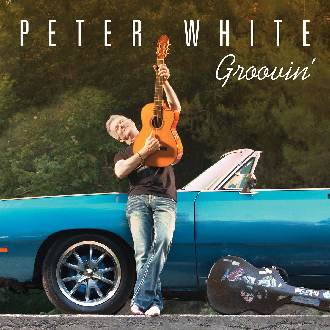 Track List:
Track List:
- Groovin’ (4:30)
- Do I Do (4:55)
- (Sittin’ On) The Dock of the Bay (4:38)
- How Long (5:42)
- I Can See Clearly Now (4:39)
- I Heard It Through the Grapevine (5:04)
- Never Knew Love Like This Before (6:31)
- Sleepwalk (4:18)
- When Will I See You Again (4:44)
- Here, There and Everywhere (2:47)

Photo Credit – Lori Stoll




comment closed